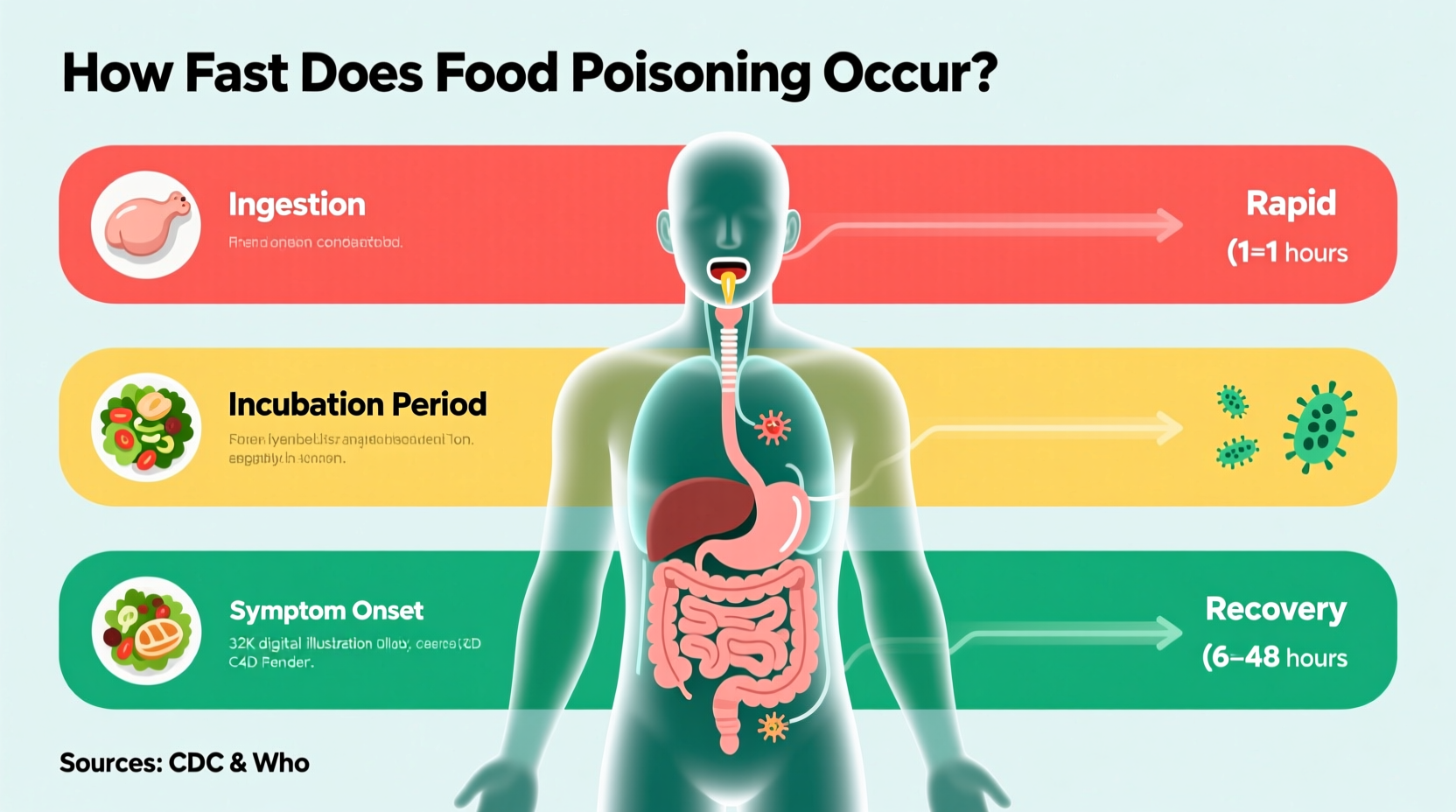Wondering how fast does food poisoning occur after eating contaminated food? You're not alone. Each year, 1 in 6 Americans experiences foodborne illness, and knowing the timeline could help you determine if your stomach upset is something more serious. This guide provides medically accurate information about symptom onset times for different pathogens, helping you recognize when to seek medical care.
Understanding Food Poisoning Timelines
Food poisoning doesn't follow a single predictable schedule. The time between consuming contaminated food and experiencing symptoms—known as the incubation period—varies significantly based on the culprit behind your illness. This variability explains why two people eating the same meal might feel sick at different times.
| Pathogen Type | Typical Onset Time | Common Sources |
|---|---|---|
| Staphylococcus aureus | 30 minutes to 8 hours | Deli meats, salads, pastries |
| Bacillus cereus (vomiting type) | 1-6 hours | Fried rice, other starches |
| Salmonella | 6-48 hours | Raw eggs, poultry, produce |
| E. coli O157:H7 | 1-10 days (avg 3-4 days) | Undercooked beef, raw milk |
| Listeria | 1-4 weeks | Soft cheeses, deli meats |
| Hepatitis A | 15-50 days | Contaminated water, shellfish |
This timeline evidence comes directly from the Centers for Disease Control and Prevention, which tracks foodborne illness patterns across the United States. Notice how dramatically onset times can vary—from mere minutes to several weeks.
Symptom Onset by Timeframe
Within 30 Minutes to 6 Hours
If symptoms hit you within this window, you've likely ingested a preformed toxin. These toxins don't require bacterial growth in your body—they're already present in the food you ate. Common culprits include:
- Staphylococcus aureus: Causes sudden, violent vomiting
- Bacillus cereus (vomiting type): Often from improperly stored rice
- Ciguatera fish poisoning: From certain tropical fish
While uncomfortable, these types usually resolve within 24 hours without medical treatment. However, severe dehydration from persistent vomiting warrants medical attention.
6 to 24 Hours After Exposure
This is the most common timeframe for food poisoning symptoms to appear. During this period, bacteria have multiplied enough in your digestive system to cause noticeable symptoms. Key pathogens include:
- Salmonella: Causes diarrhea, fever, and abdominal cramps
- Shigella: Produces severe diarrhea, often bloody
- Most Campylobacter cases: One of the most common foodborne illnesses
According to the FDA Food Code, proper temperature control prevents most bacteria from reaching these dangerous levels. Keeping cold foods below 40°F (4°C) and hot foods above 140°F (60°C) significantly reduces risk.

1 to 3 Days After Exposure
Some pathogens take longer to make you feel ill. If symptoms develop during this window, consider:
- E. coli O157:H7: Can cause severe abdominal pain and bloody diarrhea
- Clostridium perfringens: Often called "the cafeteria germ" from large-batch cooking
- Vibrio: Associated with raw or undercooked shellfish
The World Health Organization emphasizes that proper cooking temperatures eliminate most of these pathogens. For example, cooking ground beef to 160°F (71°C) kills E. coli bacteria.
Delayed Onset (1 Week or Longer)
Some foodborne illnesses have surprisingly long incubation periods:
- Listeria: Symptoms may take up to 70 days to appear, particularly dangerous for pregnant women
- Hepatitis A: Can cause liver inflammation weeks after exposure
- Cyclospora: Causes prolonged diarrhea, often from contaminated produce
This delayed onset creates a significant challenge for identifying the source of contamination. The CDC tracks listeria outbreaks that sometimes take months to trace back to their origin due to this extended incubation period.
When to Seek Medical Attention
While most food poisoning cases resolve on their own, certain symptoms require immediate medical care. Contact a healthcare provider if you experience:
- Diarrhea lasting more than 2 days
- Severe dehydration (dry mouth, dizziness, reduced urination)
- Blood in stool or vomit
- Neurological symptoms like blurred vision or muscle weakness
- Fever above 102°F (38.9°C)
Vulnerable populations—including infants, elderly adults, pregnant women, and immunocompromised individuals—should seek medical advice sooner rather than later. For these groups, even mild symptoms can escalate quickly.
Preventing Food Poisoning: Practical Steps
Understanding how fast does food poisoning occur helps you recognize symptoms, but prevention remains your best defense. Follow these evidence-based food safety practices:
Temperature Control
The FDA's food safety guidelines emphasize the "danger zone" between 40°F and 140°F (4°C-60°C), where bacteria multiply rapidly:
- Refrigerate perishables within 2 hours (1 hour if above 90°F/32°C)
- Thaw frozen foods in the refrigerator, not on the counter
- Use a food thermometer to verify internal cooking temperatures
Safe Food Handling Practices
Implement these kitchen habits to reduce contamination risk:
- Wash hands thoroughly before handling food and after touching raw meat
- Use separate cutting boards for raw meats and produce
- Clean kitchen surfaces with appropriate sanitizers
- Avoid cross-contamination by keeping raw and cooked foods separate
High-Risk Food Awareness
Be extra cautious with foods more likely to cause illness:
- Raw or undercooked eggs (use pasteurized when possible)
- Raw shellfish (oysters, clams)
- Unpasteurized dairy products
- Raw sprouts (alfalfa, bean sprouts)
- Pre-cut fruits and vegetables
Remember that food poisoning symptoms can vary widely in how fast they occur after eating contaminated food. When in doubt about a food's safety, the USDA's simple advice applies: "When in doubt, throw it out."











 浙公网安备
33010002000092号
浙公网安备
33010002000092号 浙B2-20120091-4
浙B2-20120091-4